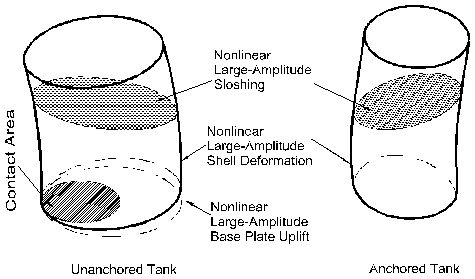 |
Liquid storage tanks are important components of lifeline and industrial facilities. They are critical elements in municipal water supply and fire fighting systems, and in many industrial facilities for storage of water, oil, chemicals and liquefied natural gas. Behavior of large tanks during seismic events has implications far beyond the mere economic value of the tanks and their contents. If, for instance, a water tank collapses, as occurred during the 1933 Long Beach and the 1971 San Fernando earthquakes, loss of public water supply can have serious consequences. Similarly, failure of tanks storing combustible materials, as occurred during the 1964 Niigata, Japan and the 1964 Alaska earthquakes, can lead to extensive uncontrolled fires. Many researchers have investigated the dynamic behavior of liquid storage tanks both theoretically and experimentally. Investigations have been conducted to seek possible improvements in the design of such tanks to resist earthquakes. Intensive research on the subject started in the late 1940s in fields of aerospace technology. The emphasis of those studies was on the influence of the vibrational characteristics of liquid containers on the flight control system of space vehicles (e.g. [2]).
Liquid storage tanks can be found in many configurations: elevated, ground-based, and underground. Steel ground-based tanks consist essentially of a steel wall that resists outward liquid pressure, a thin flat bottom plate that prevents liquid from leaking out, and a thin roof plate that protects contents from the atmosphere. It is common to classify such tanks in two categories depending on support conditions: anchored and unanchored tanks, as illustrated in Figure (1.1). Anchored tanks must be connected to large foundations to prevent the uplift in the event of earthquake occurrence. However, improperly detailed anchors may damage the shell under seismic loading resulting in a ripped tank bottom. Hence, it is common, particularly for large size tanks, to support the shell on a ring wall foundation without anchor bolts and to support the bottom plate on a compacted soil though, sometimes, ring walls are omitted. Based on the orientation of the axis of symmetry, anchored tanks are either horizontal or vertical. Circular vertical tanks made of carbon steel are more numerous than any other type because they are efficient in resisting liquid hydrostatic pressure mostly by membrane stresses, simple in design, and easy in construction.